Christo and Jeanne-Claude retrospective sheds light on artists’ storied careers
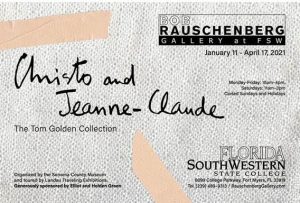 CHRISTO & JEANNE-CLAUDE: The Tom Golden Collection opened in the Bob Rauschenberg Gallery at Florida SouthWestern State College on January 11. This traveling retrospective surveys the extraordinary career of artists Christo and Jeanne-Claude through collages, prints, photographs, drawings and objects. Drawn from the permanent collection of the Sonoma County Museum—the most extensive
CHRISTO & JEANNE-CLAUDE: The Tom Golden Collection opened in the Bob Rauschenberg Gallery at Florida SouthWestern State College on January 11. This traveling retrospective surveys the extraordinary career of artists Christo and Jeanne-Claude through collages, prints, photographs, drawings and objects. Drawn from the permanent collection of the Sonoma County Museum—the most extensive 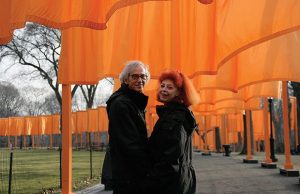 private collection in the United States—the exhibition spans 37 years of the Christo’s career.
private collection in the United States—the exhibition spans 37 years of the Christo’s career.
Christo and Jeanne-Claude were famous for large-scale environmental projects that temporarily altered urban and rural landscapes in Europe, the United States, Australia and Japan. Together, they changed the landscape 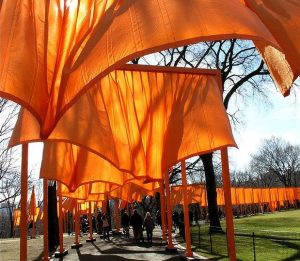 of installation art, covering large areas of space by draping thousands of square yards of various types of fabric over buildings, bridges and both land and sea masses.
of installation art, covering large areas of space by draping thousands of square yards of various types of fabric over buildings, bridges and both land and sea masses.
While each of the artists’ projects existed only briefly, they were anticipated with suspense for months, even years, while being planned. Their works defied easy categorization: always public, they were a unique mix of earth, installation and conceptual art. 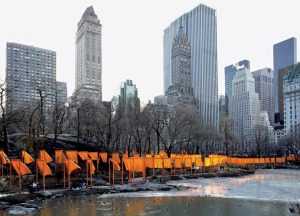 Even though the temporary nature of Christo and Jeanne-Claude’s work may suggest an anti-materialist bent, the artists were nonetheless determined to concretely realize their monumental concepts through political and physical action, if for only a short time. More closely related to architecture in their monumentality and realization than to traditional art forms, Christo and
Even though the temporary nature of Christo and Jeanne-Claude’s work may suggest an anti-materialist bent, the artists were nonetheless determined to concretely realize their monumental concepts through political and physical action, if for only a short time. More closely related to architecture in their monumentality and realization than to traditional art forms, Christo and 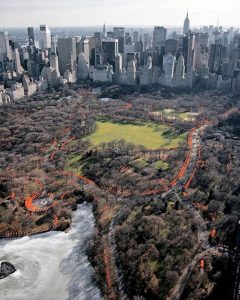 Jeanne-Claude’s projects involved an incredible number of steps—logistical, political, social, and economic. The important role that process plays in the work was unique to these artists.
Jeanne-Claude’s projects involved an incredible number of steps—logistical, political, social, and economic. The important role that process plays in the work was unique to these artists.
“The Gates” they installed in New York City’s Central Park is perhaps the most iconic example of their process and results. The installation consisted of hundreds of orange painted metal gates from which they hung flowing pieces of orange fabric that flapped and billowed in the wind. Lining the walkways throughout the entire park, the hanging fabric changed the landscape of Central Park, providing viewers a new way to connect not only with the park but with public, 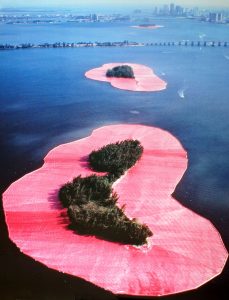 installation and conceptual art.
installation and conceptual art.
Equally important to understanding Christo and Jeanne-Claude’s work are the original drawings, collages, and prints that were integral to the creation of their large projects. Unlike many other artists, Christo and Jeanne-Claude never sought grants, sponsorships and commissions, instead treating these small-scale works as capital by using the income derived from their sale to pay for the large-scale installations. While Jeanne-Claude died in 2009 and Christo passed away last year, their work remains a widely recognized touchstone of contemporary art.
The Sonoma 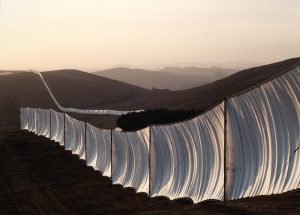 County Museum’s collection contains work made between 1962 and 2000, powerfully illustrating the art of Christo and Jeanne-Claude over that period of time.
County Museum’s collection contains work made between 1962 and 2000, powerfully illustrating the art of Christo and Jeanne-Claude over that period of time.
Christo and Jeanne-Claude first visited the Bob Rauschenberg Gallery and our Florida Southwestern State College campus in 2003. They presented a lecture on their collaborations to an appreciative 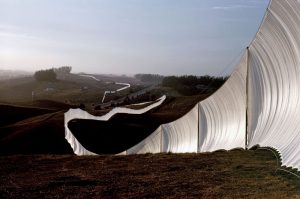 standing-room-only audience of students, faculty and community, and exhibited documentation of their many projects at that time. They generously donated hand-signed posters that were then sold to benefit our programming, and always maintained connections with their many friends here in Florida.
standing-room-only audience of students, faculty and community, and exhibited documentation of their many projects at that time. They generously donated hand-signed posters that were then sold to benefit our programming, and always maintained connections with their many friends here in Florida.
This 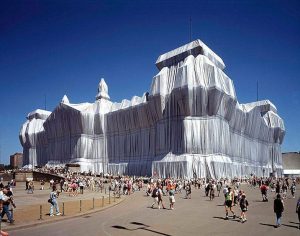 exhibition was organized by the Sonoma County Museum and is toured by Landau Traveling Exhibitions. Additional loans, including a large-scale remnant of “Running Fence” (1976), were provided by the Kent State University Art Galleries, and the exhibition was generously sponsored locally by Elliot & Holden Green.
exhibition was organized by the Sonoma County Museum and is toured by Landau Traveling Exhibitions. Additional loans, including a large-scale remnant of “Running Fence” (1976), were provided by the Kent State University Art Galleries, and the exhibition was generously sponsored locally by Elliot & Holden Green.
The exhibition will be on display through April 17.














 Tom Hall is both an amateur artist and aspiring novelist who writes art quest thrillers. He is in the final stages of completing his debut novel titled "Art Detective," a story that fictionalizes the discovery of the fabled billion-dollar Impressionist collection of Parisian art dealer Josse Bernheim-Jeune, thought by many to have perished during World War II when the collection's hiding place, Castle de Rastignac in southern France, was destroyed by the Wehrmacht in reprisal for attacks made by members of the Resistance operating in the area. A former tax attorney, Tom holds a bachelor's degree as well as both a juris doctorate and masters of laws in taxation from the University of Florida. Tom lives in Estero, Florida with his fiancee, Connie, and their four cats.
Tom Hall is both an amateur artist and aspiring novelist who writes art quest thrillers. He is in the final stages of completing his debut novel titled "Art Detective," a story that fictionalizes the discovery of the fabled billion-dollar Impressionist collection of Parisian art dealer Josse Bernheim-Jeune, thought by many to have perished during World War II when the collection's hiding place, Castle de Rastignac in southern France, was destroyed by the Wehrmacht in reprisal for attacks made by members of the Resistance operating in the area. A former tax attorney, Tom holds a bachelor's degree as well as both a juris doctorate and masters of laws in taxation from the University of Florida. Tom lives in Estero, Florida with his fiancee, Connie, and their four cats.